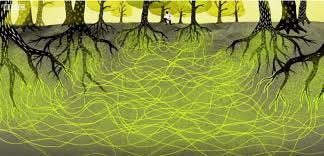Did you know that trees talk to one another? It’s true. Maybe not like the Ents in Tolkien’s Lord of the Rings trilogy, but in reality, trees actually can communicate with one another. This magnificent feat is accomplished through a network of fungi that runs underground, connecting their roots, allowing the trees to send messages over vast distances via the wood-wide web.
Mycorrhizae are a type of fungus that has a symbiotic relationship with tree roots. The mycelium, or masses of very fine threadlike branches, extend outward and much deeper beyond the reach of the tree’s roots providing its host with water and nutrients in exchange for a share of the tree’s supply of carbohydrates. The strands also connect multiple trees of the same and different species, as well as with other mycorrhizae, to form an underground system called a common mycorrhizal network. This fungi superhighway feeds, waters, and protects the trees in addition to providing a means for them to keep in touch.
Trees aren’t the only beneficiaries of this cooperative association. Around ninety percent of land plants are in a mutually beneficial relationship with fungi too. By linking into the wood-wide web, they all help each other by sharing nutrients and information. They also rid the neighborhood of unwanted guests by spreading toxic chemicals through the network. Fungal networks also boost the plants’ immune systems by triggering the production of defense-related chemicals.
Fungi are not gross or nasty as we have been led to believe. Instead, they are indispensable organisms vital to maintaining nature’s balance.
They’re neither plants nor animals but have a Kingdom all their own. As decomposers, they recycle dead materials into the soil in a form that can be reused. Without fungi, we’d be buried in leaf litter, wood, animal carcasses, and feces.
Being so small and well-hidden underground or within rotting vegetation, mycelium remain undetected until the tendrils develop a fruiting body (mushroom) above ground containing its reproductive spores. Some spores are microscopic (between 500 – 1000 can fit on the head of a pin), yet each particle can grow a new fungus.
Fungi have no chlorophyll, so they can’t make food from sunlight. Instead, they feed off dead vegetation or animals, directly off living plants and animals, or as mycorrhizae in a symbiotic relationship with plant roots.
It wasn’t until the 1970s that fungus expert Paul Stamets identified “Earth’s natural internet,” and for decades following his discovery, the extent of this fungal internet has amazed investigators. For example, researchers have uncovered how Douglas firs and paper birches share phosphorus and nitrogen back and forth during different seasons. They have also discovered that large trees known as mother trees dispense carbon and water to seedlings struggling to survive.
Did you know that if a tree falls in the forest, it does make a sound? Human ears may not hear it. Yet, the loss of life is noted by other plants within the network. The wood-wide web communicates to the rest of the forest trees that one of their brethren is dying, and all other trees send nutrients and water through mycelium to care for the trunk.
Disease and insect infestations can wreak havoc in a forest. However, the resourceful plants have developed ways to protect themselves. Studies have found that trees can send help to their neighbors via the fungal network. For instance, when a tree is attacked, it will release certain chemicals through nature’s internet to warn other trees of the danger. By having an early warning, other trees can better protect themselves by increasing toxins and repellents in their tissues to deter pests.
A fact not related to the underground system yet interesting to know: Trees also produce airborne compounds that attract the natural enemies of a particular pest.
For instance, a pine forest under attack from aphids will send out a cloud of strong perfume that ladybugs cannot resist. The voracious red and black insects will follow the scent back to the affected trees and feast on the tiny pesky aphids.
Isn’t it amazing how all living things are interconnected? When humanity refrains from interfering with Mother Nature’s balance, she’ll provide an answer to all our planet’s problems. And most of the work is completed seamlessly without us being the least bit aware of it.
Beneath our feet is an extensive network with so much activity taking place. These miniature lifelines not only send messages but selflessly pass along food and water regardless of the recipient’s size, shape, color, or age. It’s a large social network that evolved over hundreds of millions of years, with all the trees being a part of an extended family – a society.
Just imagine all the things humanity can learn from nature!
~~~~~~~~~~~~~~~~~~~~~~~~~~~~~
Dear Reader,
I'd be ever so grateful if you would take a few minutes to recommend Let's Get Our Hands Dirty to your followers on Substack and other social media platforms.
Thank you!
Greta
---------------------------
Let's Get Our Hands Dirty is a reader-supported publication. This post is free as are all my posts. Please subscribe so you can receive a notification when new articles are published. I'd love for you to become a part of our nature-loving family. Basic subscriptions are free, but if you sign up for a paid subscription as a love offering, that would be wonderful and greatly appreciated!
Have a fabulous day,
Greta
Please use the buttons below to Like, Comment, Restack, and Share my post on Substack and other social media platforms.
THANK YOU SO MUCH!







I learned about this several years back. Yet there is still so much we don't know. Fascinating.